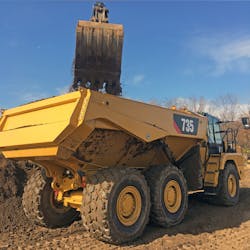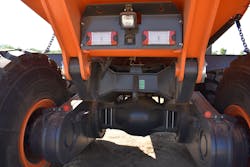Articulated dump trucks , staples at quarries and large site prep and road building sites, come with their own safety concerns because of their size, geometry, speed, and function—they are exclusively off-highway machines, called upon to traverse uneven terrain.
Their frames are tested and twisted as they negotiate grades and moguls, particularly with typical 30- to 45-ton loads. With the articulation joint and load behind the operator, the dump body's natural sway under load calls upon operators to know the body's position at all times.
Following is a look at hazards operators of articulated dump trucks need to be aware of, some tips on negotiating them, and how manufacturers have adjusted designs and used technologies to make ADTs safer.
What's dangerous about ADT operations?
Beard Construction Group of Port Allen, Louisiana, identifies some of the most prominent ADT operation hazards as part of its weekly safety moment series. They are:
- Back over incidents of people or other equipment. OSHA states that dump trucks followed by semi-trucks and ordinary pickups are responsible for the majority of back over incidents in the past 10 years on the job.
- Tip over (overturn) of entire truck or the bed of an articulating dump truck. Tip overs can cause serious injury to both the operator or ground personnel.
- Property damage incidents. Due to the sizes of these trucks and lack of room of some job sites, there is a lot of money lost due to property damage incidents.
- Contact with electrical lines.
- Slips, trips, and falls. Climbing on and off of the equipment multiple times a day puts an operator at risk for falling while getting in and out of the cab. Obvious, but still worth mentioning. The ground is a long way down from an ADT cab.
Beard advises operators to avoid backing up whenever possible, and to set up work areas and haul roads so that operators are able to pull through instead of backing up. If possible, use a spotter on a congested job site; however, any spotter needs to stay out of blind spots as well as away from the truck in case of a tip over. ADT manufacturers have added rearview camera technology to mitigate back over incidents.
To avoid tip overs, try to dump a load on flat ground if at all possible. After the load is dumped, pull up just enough to clear the load and lower the bed before driving away. Leaving the bed up while driving can result in contact with electrical lines or a tip over.
The Quarries National Joint Advisory Committee of the U.K. points out that ADTs have been subject to a myth over the years, holding that they are "designed to overturn." This is simply dangerous and should be challenged. The committee says: "The purpose of the center articulation on an ADT is to allow the two sections of the vehicle to articulate separately (twist and steer) and allow all of the wheels to maintain maximum contact with the ground all of the time, thus maximizing traction and brake efficiency. It is this feature which makes ADTs so versatile over poor terrain. It has nothing whatsoever to do with being 'designed to overturn.'"
An analysis by the committee has shown there are three main modes of overturn: the dump body overturn, the cab overturn, and the whole machine overturn.
The dump body overturn is the most common type of overturn incident where the body turns on its side leaving the cab upright. Usually these incidents do not result in significant damage to the machine or injury to the driver. However, they have the potential to result in a serious or perhaps even fatal outcome should the falling dump body come into contact with people in the close vicinity of the vehicle.
The cab overturn that leaves the dump body upright is less common. It is often a result of the rear articulated half of the vehicle lifting the cab and front wheels off the ground, allowing the cab to topple on the articulation joint. It is common for operators to suffer injury in a cab turn over incident, the committee says. In extreme cases, if a seat belt is not worn, the incidents have the potential for serious injury or fatalities. A cab overturn also causes more significant damage to the machine.
What causes an articulated dump truck to roll over?
A whole machine overturn is the least common type of overturn, where both the dump body and cab turn over. This event most often occurs at speed or involves falls from height, increasing the likelihood of a tragic outcome. The committee also listed the key causal factors common in overturn incidents, either individually or in combination:
- Soft or sticky or uncompacted ground
- Dumping too close to an edge
- Dumping on an excessive gradient or on a cross-fall
- Moving/reversing up a slope, stockpile, or embankment edge
- Carrying unstable loads such as silts and slurries
- Carrying sticky or cohesive loads such as clays and soils
- Excess speed or sharp braking, especially on corners and bends
- Poor haul road conditions
- Mechanical failure of key components such as the lifting cylinders, suspension
- Incorrect use of the differential lock
- Poor visibility/weather conditions
- Use of tailgates on cohesive materials
- Vehicle runaways
- Traveling on excessive camber and gradients
- Incorrectly inflated tires or tire blowout
- Failure of operators or site supervisors to adequately identify and assess risk.
OEM features and accessories, such as automatic traction control and differential locks, "body up" alarms and warning lights, speed limiters, dump body heating options, rear tailgates, body side extensions, and ejector bodies are meant to reduce overturn risks.
Volvo safety features
Volvo ADTs have Automatic Traction Control, and 100-percent differential locks.
“Volvo’s Automatic Traction Control lets operators focus on driving while automatically engaging and disengaging locks for the most efficient on and off-road performance,” says Rob Palermo, product manager for articulated haulers. “The Dynamic Volvo Engine Brake (VEB) system uses powerful retarders to control speed while hauling downhill, slowing down before curbs or crossroads. The torque and shift points are now dynamically adjusted against the current load, inclination, and rolling resistance, which improves brake life by reducing the need to use the brake and retarder pedal when going downhill.”
Palermo says the VEB leads to significant increases in max torque. Volvo ADTs also come equipped with full wet disc brakes on all wheels.
“Also, Volvo Dynamic Drive provides an improved gear shifting strategy that takes into consideration both the payload and the gradient of the slope,” Palermo says. “The machine will automatically detect when to choose a higher starting gear or when to shift up earlier. When conditions require, the machine will prolong the gear, ensuring maximum rim-pull.”
Another feature, called Hill Assist, holds the hauler in place on steep slopes without the need to engage the parking brake. The feature automatically activates when arriving at a complete stop on a hill and is disengaged when the operator accelerates.
Doosan ADT design features
There is also an important role for operator training and basic machine design. Doosan has designed its ADTs with the turning ring in front of the articulation joint.
“Let’s say you have a full payload, and you’re running full speed, and you need to make a tight turn,” says Jay Patel, a Doosan product specialist. “Whenever you make a sharp left turn, all that weight will be distributed to the right side of the machine, and that will cause you to have some slippage. With our design, having the turning ring in front of the articulation joint, you’ll be able to keep all of the weight distributed equally on the left and right side of the machine, so you won’t have that kind of slippage. That will give you a much safer machine, and even tire wear on all six tires.”
Patel says some ADT manufacturers use two rear axles, while Doosan uses one axle with a tandem bogie design. “This allows us to have a greater range of motion and keep maximum ground contact with all six wheels on the ground. It’s safer going over uneven terrain; the wheels will operate independently.”
Telematics, payload weighing, and tire monitoring systems can also help.
Telematics can be used to record and transmit a variety of data relating to payload, engine/transmission status, fuel usage, and other efficiency data. Machine systems can be typically monitored to record events and operator warning alarms such as overheating or advanced notice of an engine oil change. They may also record significant events such as inclinometer tipping warnings, heavy braking, and inappropriate gear selection. It is good practice that data downloaded from machine systems is regularly reviewed with the operator to identify improvements in driving habits and efficiency. Specific training can be initiated from data.
A payload weighing system, or at a minimum, a load indication light, is an externally mounted indicator to inform the excavator or loader operator when the machine has the correct payload, and reduces the risk of an ADT overturn due to overload.
As an example, here's how Doosan's standard system works. Operators can view each load’s weight on the LCD screen in the operator cab. An exterior traffic light-style indicator alerts excavator and wheel loader operators filling the ADT. They include three lights: red, yellow, and green. If the green light is illuminated, the truck is within the rated payload. If the yellow light is illuminated, the operator is within 10 percent of the rated payload. If the red light is illuminated, the operator has overloaded the truck for the allowed payload.
Tip over prevention facts from the Texas Safety at Work Division of Workers' Compensation focus on uneven loading and impeded dumping.
When a large amount of material is loaded in the upper portion of a raised box, the truck becomes off-balanced and unstable. Always load material evenly in the bed of the truck and pay attention to how the load flows from the bed while dumping.
It takes practice to learn how different materials flow while dumping or spreading. However, sometimes material does not move out of the top portion of the box or does not flow out of one side of the top portion as expected. Also, the end gate may fail to open, lifting the dump body in the air. The uneven distribution of the load can decrease the truck's stability and result in a tip-over. Also, cold weather may cause materials to freeze and stick to the box when dumping. Do not leave loads in dump boxes overnight during the winter. OEMs offer heated beds to combat solidification of cold-weather loads.
Tire monitoring may be an option on some models and can also be retrofitted as a non-OEM item. It is used to inform the operator of tire pressures and temperatures. Tire pressure is important as rear tire deflection has a significant influence on stability on rear tip ADTs, as the weight is transferred from the front to the rear during tipping. Low tire pressure can also impact stability during cornering.
Similarly, on the monitoring front, Liebherr has incorporated a dump bed lift height limit feature on its TA 230 for work in height-critical areas.
Caterpillar safety features
Caterpillar's 735 ADT features three automated systems to aid safety and help operators: Automatic Retarder Control; Assisted Hoisting Control; and Stability Assist—all proprietary Caterpillar designs.
The 735’s retarding system uses an engine compression brake, a fluid-type retarder in the transmission, and the truck’s service brakes. The engine brake does most of the heavy lifting, Cat says, supplying some 80-plus percent of total retarding force. The system has four settings: off, medium, high, and automatic. Selecting either the medium or high setting determines the degree of retardation, essentially telling the engine brake to use either four or six cylinders, respectively. In the automatic mode, the system has more choices—off, low, medium, and high—which are automatically selected as operating conditions dictate.
Cat says that automating the retarder relieves the truck operator of one of the most demanding tasks in controlling the vehicle—deciding when and to what degree to apply retarding force. Conversely, the company didn’t want to take that control away from experienced operators if manual control is their preference—they can simply shut off the system.
Likewise, if the operator chooses to control all aspects of the dumping process, the 735’s Hoist Assist system can be shut off with a push of a switch on the right console. But if the system is switched on, the operator simply lifts another switch, positioned on the forward side of the automotive-type transmission controller, to initiate a series of automatic functions (provided the truck is either stopped or travelling less than 4 kph): transmission neutralizes; service brakes apply; engine speed elevates; and body raises. A second click of the switch reverses the process and allows a soft landing of the body on the frame.
The 735’s Stability Assist system uses two inertial measurement units (position-sensing instruments using gyroscopes and accelerometers) to continuously monitor the degree of roll of the body and the tractor, as well as the longitudinal angle of the truck. The system alerts the operator via the monitor when any of these parameters are approaching a critical point during travel or dumping, stopping the dumping process if instability is sensed.
Texas officials also stress that preventive maintenance and regular inspections play an important role in eliminating tip overs. Check tire pressure daily and ensure that it is equal on all sides of the truck. Examine and lubricate pins and bushings regularly, particularly the tailgate components. A tailgate that fails to open can result in the load shifting rearward, lifting the truck in the air.
Maintain and inspect suspension systems under load to make sure they work properly and provide even suspension. Replace weak systems immediately. Also, inspect hoist cylinders regularly, and when needed, replace them with cylinders of the same size and operating pressure. Never replace worn cylinders with smaller cylinders or with cylinders rated at a lower operating pressure.
About the Author
Frank Raczon
Raczon’s writing career spans nearly 25 years, including magazine publishing and public relations work with some of the industry’s major equipment manufacturers. He has won numerous awards in his career, including nods from the Construction Writers Association, the Association of Equipment Manufacturers, and BtoB magazine. He is responsible for the magazine's Buying Files.


